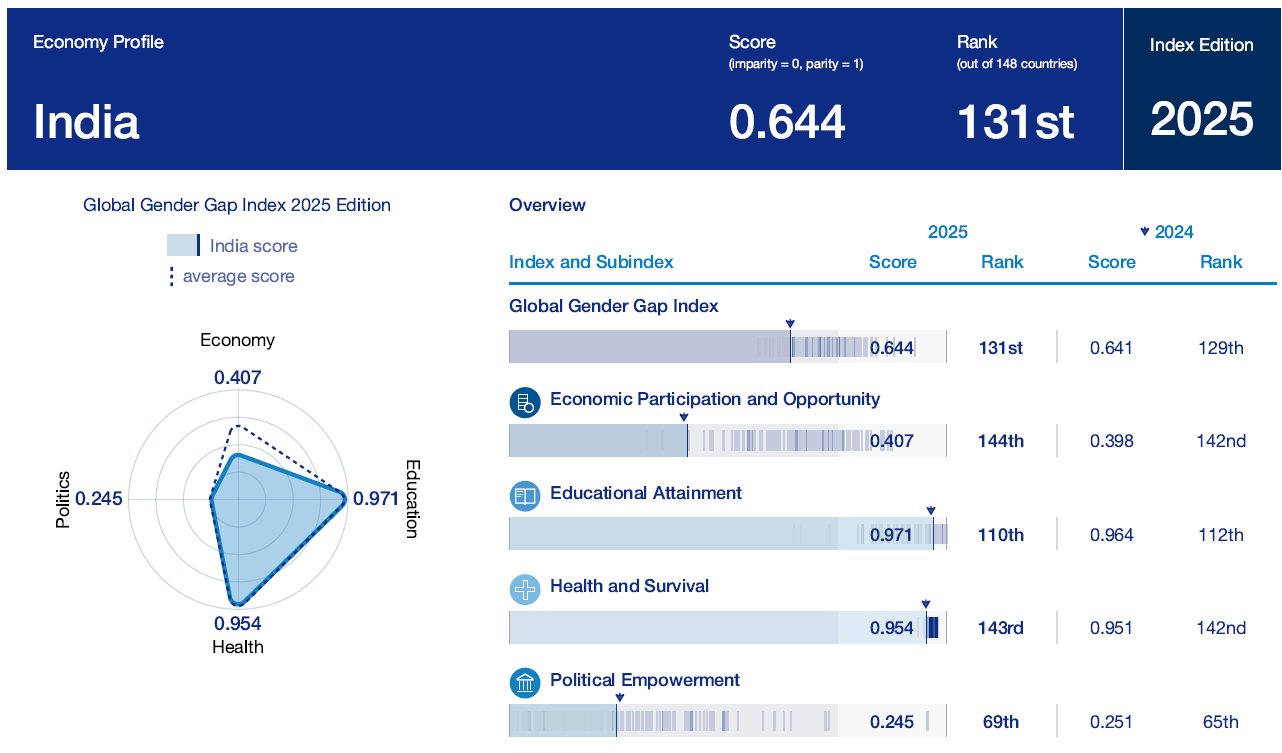Global Gender Gap Report 2025

- 14 Jun 2025
In News:
The 19th edition of Global Gender Gap Report 2025 was released by World Economic Forum (WEF).
Key Highlights:
Countries Covered: 148
Global Parity Status:
- Overall Gender Gap Closed: 68.8%
- Estimated Time to Full Parity: 123 years (at current pace)
Assessment Criteria (Four Dimensions):
- Economic Participation and Opportunity
- Educational Attainment
- Health and Survival
- Political Empowerment
The index uses a parity score (0–100%) to quantify gender equality, where 100% indicates full parity.
India’s Performance (Rank: 131/148)
- Parity Score: 64.1%
- South Asia Rank: Among the lowest; only Maldives (138) and Pakistan (148) rank below
- India’s 2024 Rank: 129 (slipped 2 positions in 2025)
Domain-wise Performance:
- Economic Participation and Opportunity
- Improved: Score increased by 0.9 percentage points to 40.7%
- Earned Income Parity: Rose from 28.6% to 29.9%
- Labour Force Participation: Stagnant at 45.9%
- Insight: Despite income parity gains, the gap in actual earnings and participation remains wide.
- Educational Attainment
- Near Parity Achieved: 97.1%
- Driven by rising female literacy and higher tertiary enrolment
- Challenge: Translating education into workforce participation remains limited.
- Health and Survival
- Marginal Gains: Improved parity in sex ratio at birth and healthy life expectancy
- However, overall life expectancy declined for both genders, muting the parity effect.
- Political Empowerment
- Significant Decline:
- Women MPs fell from 14.7% to 13.8%
- Women ministers dropped from 6.5% to 5.6%
- Trend: Continued decline from the 2019 peak of 30% female political representation
- Significant Decline:
South Asia and Global Comparison
- Bangladesh: Best performer in South Asia, ranked 24th globally (up by 75 positions)
- Other Neighbours:
- Bhutan (119),
- Nepal (125),
- Sri Lanka (130),
- Maldives (138),
- Pakistan (148 – last)
- Global Top 5 Countries:
- Iceland (Top for 16th year in a row)
- Finland
- Norway
- United Kingdom
- New Zealand
Key Global Insights
- Women in Workforce: 41.2% of global workforce
- Leadership Representation: Only 28.8% of leadership roles are held by women
- Despite post-pandemic recovery in gender parity, leadership gaps and decision-making roles remain major bottlenecks.
Implications for India
- The report underscores that gender parity is not just a social imperative, but also crucial for inclusive and resilient economic growth.
- India’s sluggish progress in political empowerment and gender wage gap highlight the need for institutional reforms, affirmative actions, and gender-sensitive policies in governance, employment, and leadership.
